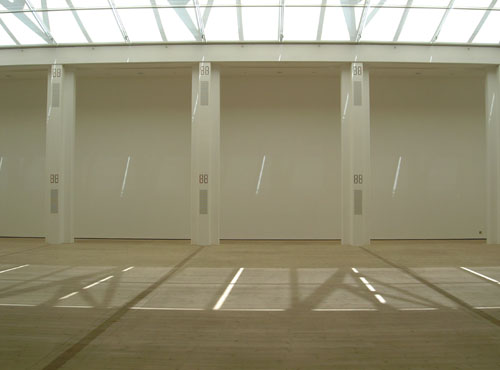SUSAN HILLER: RECALL @ BALTIC, GATESHEAD (1 MAY - 18. JULY 2004), MUSEU DE ARTE CONTEMPORÂNEA DE SERRALVES, PORTO (15 OCTOBER 2004 - 9 JANUARY 2005) AND KUNSTHALLE BASEL (30 JANUARY - 27 MARCH 2005)

The double video installation An Entertainment, 1990, stands at the beginning of Hiller's substantial exhibition at Baltic that presents work from the past 35 years. It is very convincing in stating that this diversion is anything but harmless. The degree of aggression and violence the Punch and Judy puppets show towards each other in the short sections from which these films are assembled is quite astonishing. The contrast with the fairground music that intersects the scenes and the size of the projection renders them even more threatening.
This show was brought together by James Lingwood who, besides choosing very prominent pieces, also chose some more unassuming works, which detail Hiller's lasting interest in the ephemeral and the obscure. There are the incinerated remains of her own paintings, Collected Works, 1968-72, the collection of Split Hairs: The Art of Alfie West, 1998, and of course her most well-known From the Freud Museum, 1991-97, in which she mimics a museum collection, with its specimens laid out in crafted storage boxes - connecting objects and papers from the Freud Museum to often banal found objects.
Clinic, 2004, has been newly commissioned for Baltic's Level 4 gallery, an enormous two-storey space that is void but for 10 columns, five on either side, and a viewing platform on the level above. Hiller works this space with minimal material intervention. The T-shaped columns have simply a fourth joist added at the front, thus making their cross-section quite literally cross-shaped. In each of these built-on additions, Hiller incorporates two speakers behind cut-out grills, one at eye-level and one high up in the space. A digital number is also cut into the material above each grill, numbering the speakers from 1 to 20 and lighting up whenever a speaker is active. The vast space of the gallery fills with the sound from these speakers, with voices, and with the bright light that filters through the skylights of the gallery.
The voices heard are those of many different people in quite a few distinguishable tongues; they tell stories of near death out of body experiences and of bright white lights. Volunteers from Gateshead and Newcastle were used to record these accounts, which were taken from a variety of sources, from books, documentaries and the internet. Several hundred of these were recorded, in the accents and languages of the region, thus investing these texts with a local aura that bridges the gap between the listeners and the anonymous texts.
Sometimes the speakers are activated at random, one after the other, creating a pattern of movement throughout the space; sometimes the voices are only played atop the room and sensors behind the lower grills trigger the sound to shoot down whenever somebody is nearby, and sometimes the voices are played more rapidly, rising to an indecipherable cacophony before coming suddenly to a silent halt.
The large, basilica-like space and the semi-religious tales of eternity sounding through it, provide the audience with an almost spiritual experience. As in many of Hiller's other works, the viewers are seduced by the formal accuracy and then captured in the piece by highly individual and personal accounts. Whilst initially Clinic appears to be quite austere, the privacy of the reports, which relate emotional stories of survival and recovery, invest the piece with an affecting quality. This is aided by an almost voyeuristic pleasure - or rather the pleasure of eavesdropping - to be gained through listening to these personal tales.
This is also what compares Clinic to Witness, 2000, a sound installation that consists of 400 small speakers, suspended on their wires from a circular area of the ceiling. They all hang at different heights, relating to the possible ear-levels of prospective listeners. They also play a wide array of different voices and languages, also reading out stories. These stories are accounts of UFO sightings, each describing the perception of something that might or might not have been there, each in the belief that the witnessed event was neither natural nor man-made. Standing within the space of these speakers, one is immersed in a continuous whispering sound, but only with an ear next to a speaker can a story be clearly discerned. The speakers themselves with their circular shape seem to be small flying saucers dangling in space. When occasionally the multitude of sound fades out and only one voice reverberates from several speakers, this seems almost like a paranormal experience, as the voice seems to hover in space without being traceable to any of the speakers.
In the 60s, Konstantin Raudive, a Latvian psychologist, kept recording voices in empty rooms. He interpreted these strange crackling sounds as voices of the dead, attributing them to a selection of past celebrities wanting to communicate. In Magic Lantern, 1987, Susan Hiller uses a tape of these recordings as the sound for a slide projection. With three projectors, she demonstrates the optical principle of additive colour mixing (red + yellow + blue = white) which is also not quite obvious in its effect. Both parts of this work deal with perception, yet one is scientifically supported while the other has not been disproved.
For over 30 years now, Hiller has been dealing with the paranormal, the para-scientific, sometimes with what some people would call para-art. Yet, with all her vested interest in these areas, Hiller is not so much concerned with the occult itself but with its societal preconditions. How are these phenomena replicated in the minds of many different people? How do myths originate and what purpose do they serve?
